Study on the Fracture Law of Inclined Hard Roof and Surrounding Rock Control of Mining Roadway in Longwall Mining Face
Abstract
:1. Introduction
2. The Inclined Fracture Structure and Mechanical Model of the Working Face Roof
2.1. Inclined Fracture Structure of Working Face Roof
2.2. Mechanical Model
3. Model Experiment
3.1. Project Overview
3.1.1. Geological Conditions
3.1.2. Mining Conditions
3.2. Physically Similar Material Simulation
3.2.1. Model of Similar Design
3.2.2. Monitoring Design
3.2.3. Excavation Design
3.3. Results
3.3.1. Roof Fracture Structure
3.3.2. Analysis of Stress Changes
3.3.3. Analysis of MS Monitoring Results
4. On-Site Monitoring
4.1. Engineering Practice Conditions
4.2. Engineering Monitoring Effect
4.2.1. Monitoring Plan
4.2.2. Monitoring Results
5. Conclusions
Author Contributions
Funding
Acknowledgments
Conflicts of Interest
References
- Qian, M.G.; Shi, P.W.; Xu, J.L. Mine Pressure and Rock Formation Control, 2nd ed.; China University of Mining and Technology Press: Xuzhou, China, 2010; pp. 268–276. [Google Scholar]
- Wang, J.H. Key technology for fully-mechanized top coal caving with large mining height in extra-thick coal seam. J. China Coal Soc. 2013, 38, 2089–2098. [Google Scholar]
- Xu, X.L.; Wei, H.; Tian, S.C. Study on influence law of coal pillar size on roof break structure and fracture development in fully mechanized working face. J. China Coal Soc. 2015, 40, 850–855. [Google Scholar]
- Wang, H.S.; Zhang, D.S.; Li, S.G. Rational width of narrow coal pillar based on the fracture line location of key rock B in main roof. Chin. J. Rock Mech. Eng. 2014, 31, 10–16. [Google Scholar]
- Zhu, D.; Wang, J.; Gong, W.; Sun, Z. Model Test and Numerical Study on Surrounding Rock Deformation and Overburden Strata Movement Law of Gob-Side Entry Retaining via Roof Cutting. Minerals 2020, 10, 458. [Google Scholar] [CrossRef]
- Zhang, X.Y.; Pak, R.Y.; Gao, Y.B.; Liu, C.K.; Zhang, C.; Yang, J.; He, M.C. Field experiment on directional roof presplitting for pressure relief of retained roadways. Int. J. Rock Mech. Min. Sci. 2020, 129, 134. [Google Scholar] [CrossRef]
- Zhang, G.C.; He, F.L.; Lai, Y.H. Reasonable width and control technique of segment coal pillar with high-intensity fully-mechanized caving mining. J. China Coal Soc. 2016, 41, 2188–2194. [Google Scholar]
- Cui, F.; Dong, S.; Lai, X.P.; Chen, J.Q.; Cao, J.T.; Shan, P.F. Study on Rule of Overburden Failure and Rock Burst Hazard under Repeated Mining in Fully Mechanized Top-Coal Caving Face with Hard Roof. Energies 2019, 12, 4780. [Google Scholar] [CrossRef] [Green Version]
- Cui, F.; Jia, C.; Lai, X.P.; Chen, J.Q. Study on evolution characteristics and stability of overlying strata structure in ascending mining of coal seams with strong shock tendency at close range. Chin. J. Rock Mech. Energies 2020, 39, 507–521. [Google Scholar]
- Dai, J.; Shan, P.; Zhou, Q. Study on Intelligent Identification Method of Coal Pillar Stability in Fully Mechanized Caving Face of Thick Coal Seam. Energies 2020, 13, 305. [Google Scholar] [CrossRef] [Green Version]
- Lai, X.P.; Dai, J.J.; Li, C. Analysis on disaster characteristics of overlying rock in steeply inclined coal seams. J. China Coal Soc. 2020, 45, 122–130. [Google Scholar]
- Kang, H.P.; Wu, Y.Z.; He, J. Rock bolting performance and field practice in deep roadway with rock burst. J. China Coal Soc. 2015, 40, 2225–2233. [Google Scholar]
- Shen, B.Y.; Duan, Y.; Luo, X.; van de Werken, M.; Bongani, D.; Chen, L.; Onur, V.; Ismet, C. Monitoring and modelling stress state near major geological structures in an underground coal mine for coal burst assessment. Int. J. Rock Mech. Min. Sci. 2020, 129, 104294. [Google Scholar] [CrossRef]
- Meng, F.; Wen, Z.; Shen, B.; Jiang, Y.; Shi, S.; Zhao, R. Applicability of Yielding–Resisting Sand Column and Three-Dimensional Coordination Support in Stopes. Materials 2019, 12, 2635. [Google Scholar] [CrossRef] [PubMed] [Green Version]
- Yin, S.F.; Cheng, G.Y.; He, F.L. An asymmetric support technique for fully-mechanized coal roadway nearby narrow pillar based on the fracture position analysis in basic roof. Chin. J. Rock Mech. Eng. 2016, 35, 3162–3174. [Google Scholar]
- Zha, W.H.; Li, X.; Hua, X.Z. Impact and application on narrow coal pillar for roadway protecting from fracture position of upper roof. J. China Coal Soc. 2014, 39, 2225–2233. [Google Scholar]
- Wang, Z.Q.; Guo, L.; Su, Z.H. Layout and combined support technology of alternate exterior stagger arrangement roadway and adjacent roadways in inclined and medium-thick coal seam. J. China Coal Soc. 2020, 45, 542–555. [Google Scholar]
- Wang, Z.T.; Qian, M.G. The calculating method of the first weighting span of main roof. J. China U Min. Technol. 1989, 2, 9–18. [Google Scholar]
- Sakanoi, R.; Shimazaki, T.; Xu, J.; Higuchi, Y.; Ozawa, N.; Sato, K.; Hashida, T.; Kubo, M. Communication: Different behavior of Young’s modulus and fracture strength of CeO2: Density functional theory calculations. J. Chem. Phys. 2014, 140, 121102. [Google Scholar] [CrossRef]
- LLawe, N.V.; Zimmerman, J.A.; Wong, B.M. Breaking Badly: DFT-D2 Gives Sizeable Errors for Tensile Strengths in Palladium-Hydride Solids. J. Chem. Theory Comput. 2015, 11, 5426–5435. [Google Scholar]
- Cui, F.; Yang, Y.; Lai, X.; Jia, C.; Shan, P. Experimental Study on the Effect of Advancing Speed and Stoping Time on the Energy Release of Overburden in an Upward Mining Coal Working Face with a Hard Roof. Sustainability 2019, 12, 37. [Google Scholar] [CrossRef] [Green Version]
- Cui, F.; Zhang, T.; Lai, X.; Cao, J.; Shan, P. Study on the Evolution Law of Overburden Breaking Angle under Repeated Mining and the Application of Roof Pressure Relief. Energies 2019, 12, 4513. [Google Scholar] [CrossRef] [Green Version]
Publisher’s Note: MDPI stays neutral with regard to jurisdictional claims in published maps and institutional affiliations. |

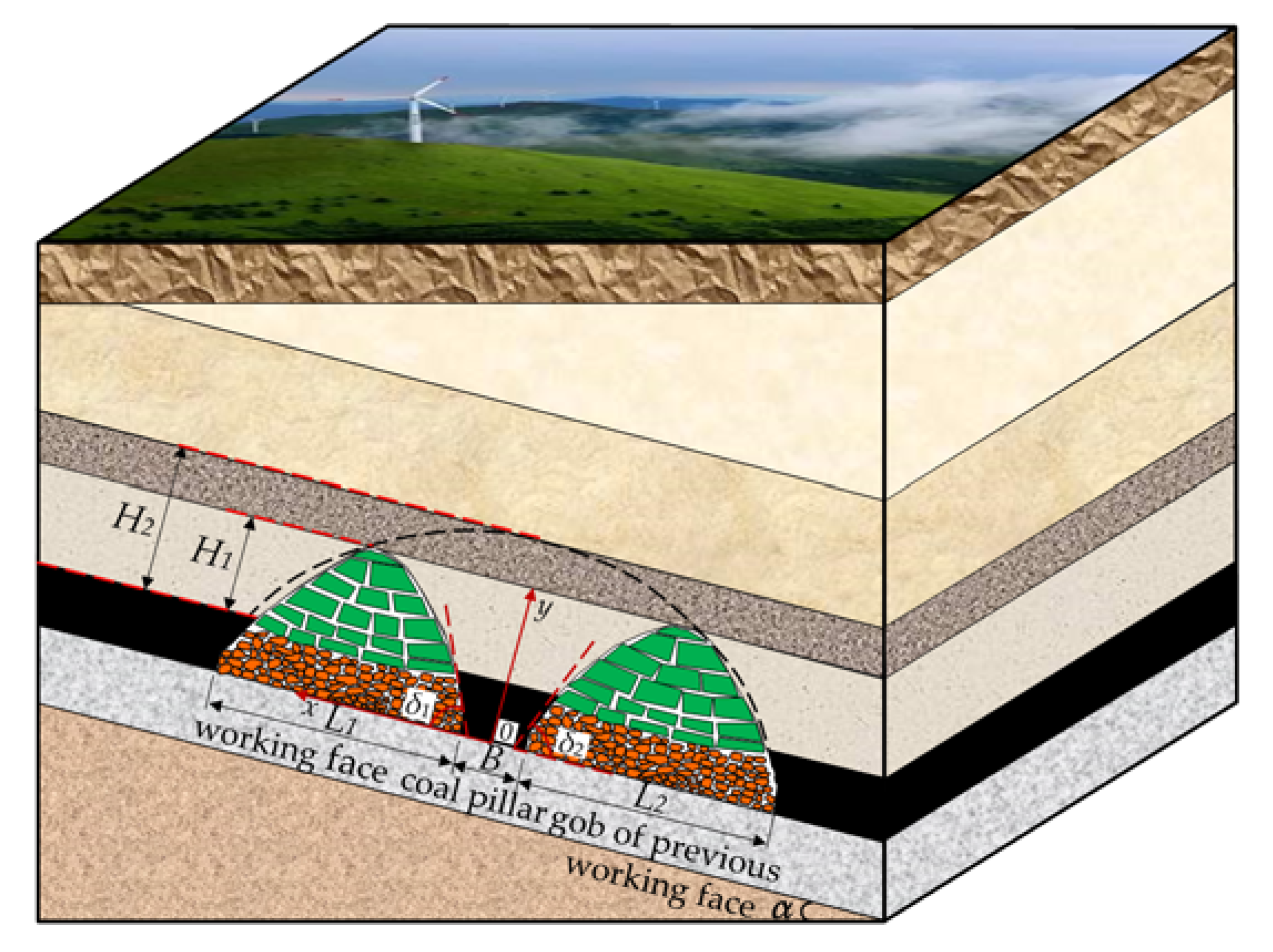
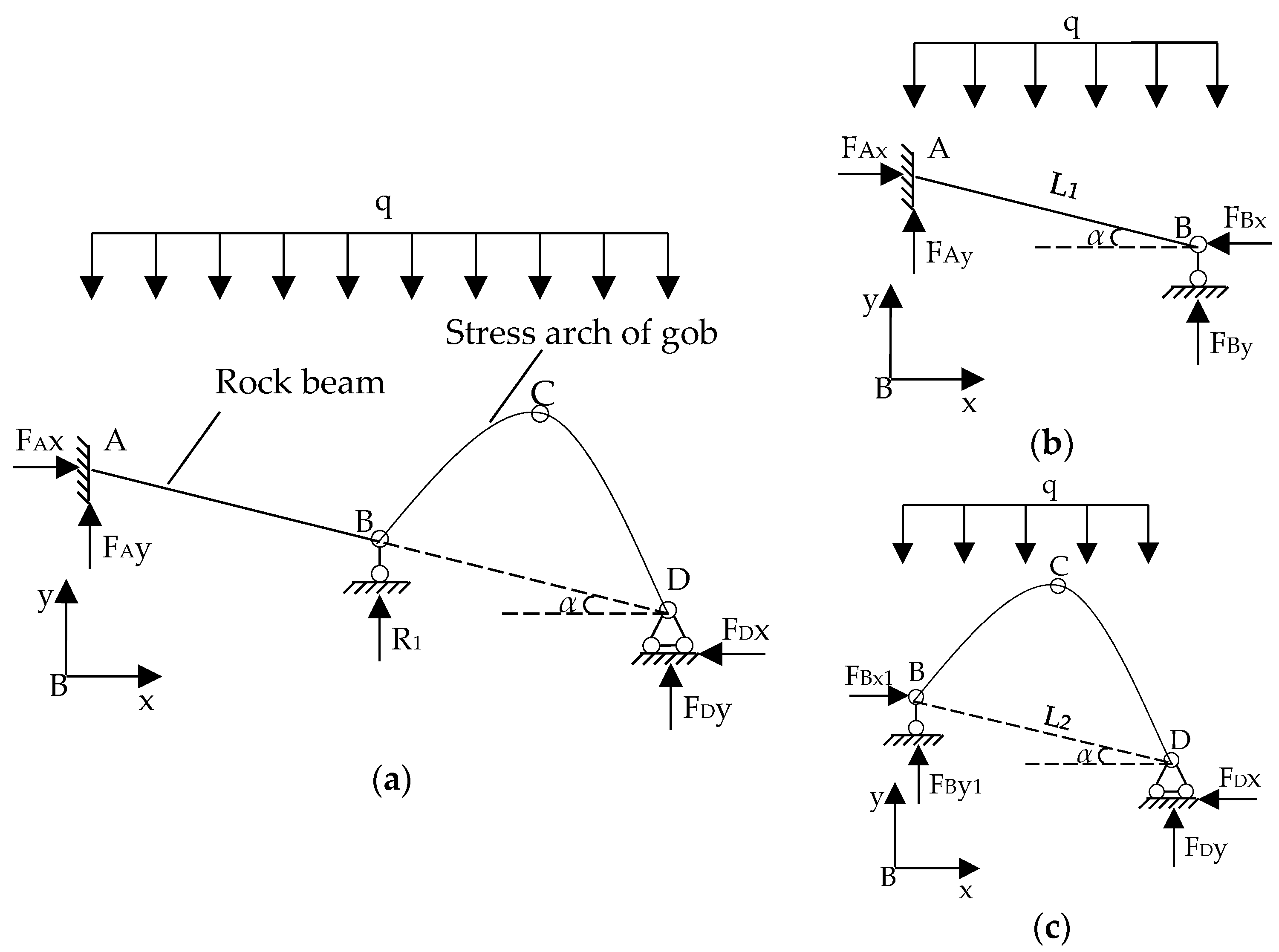

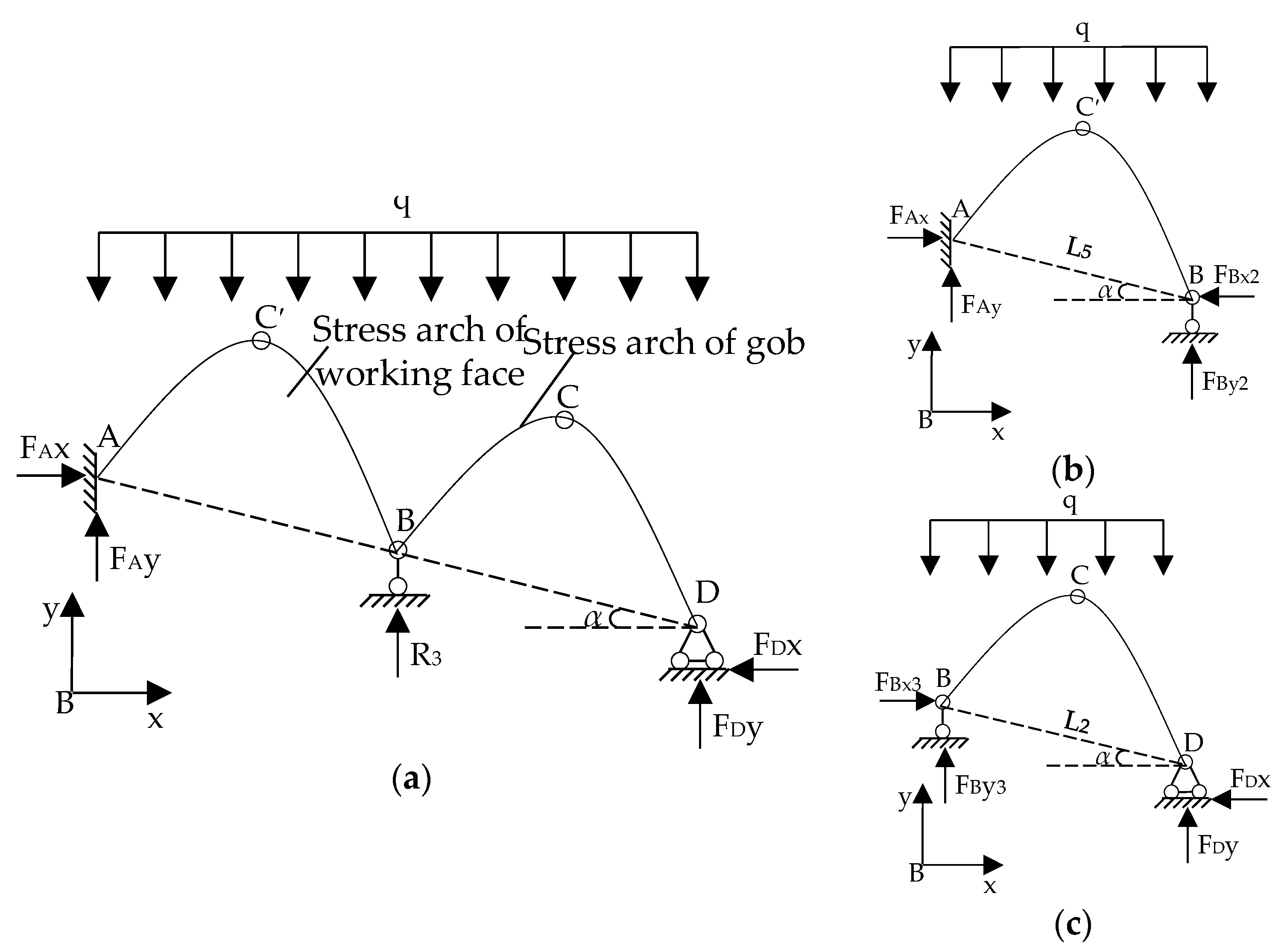

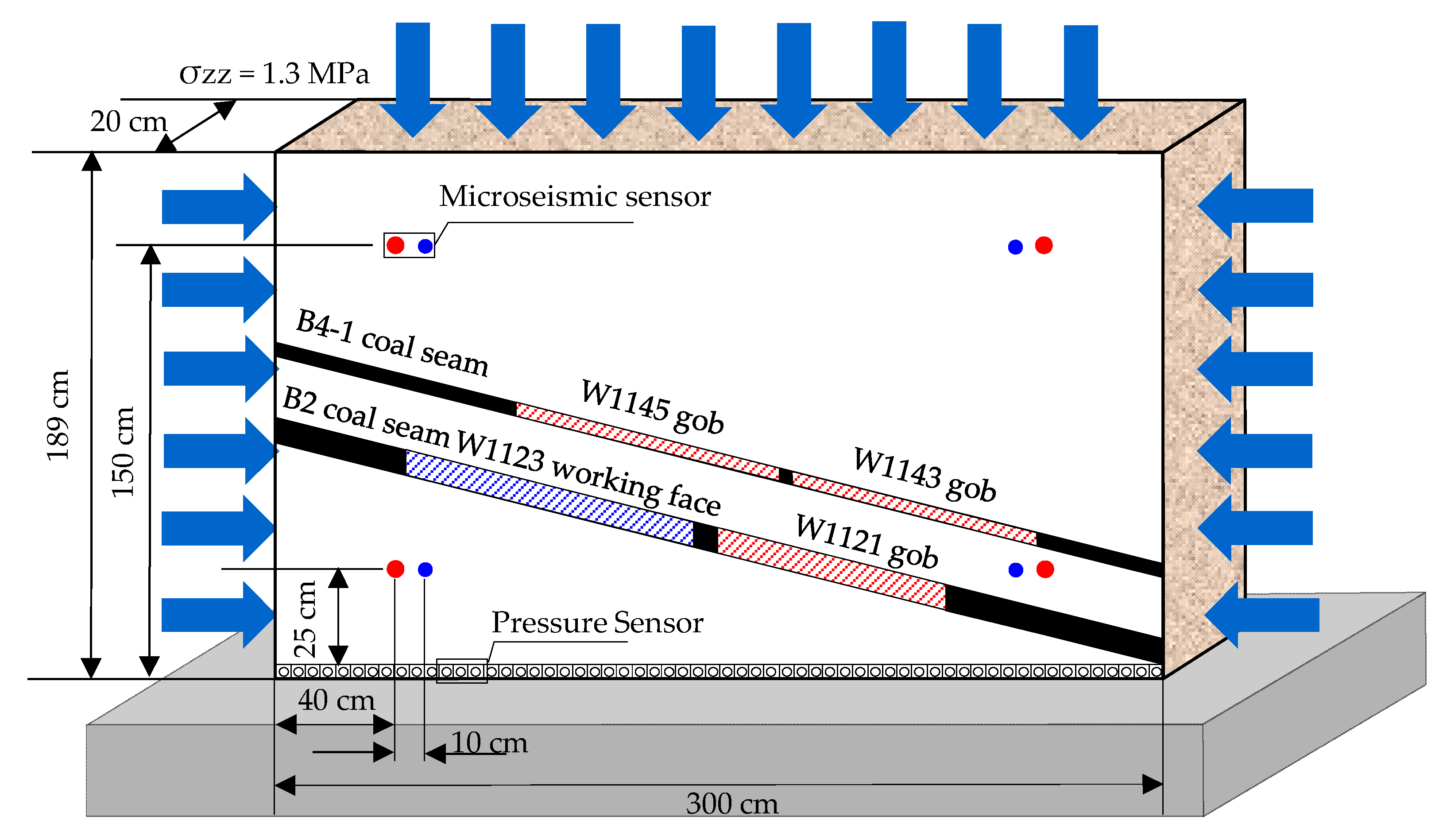


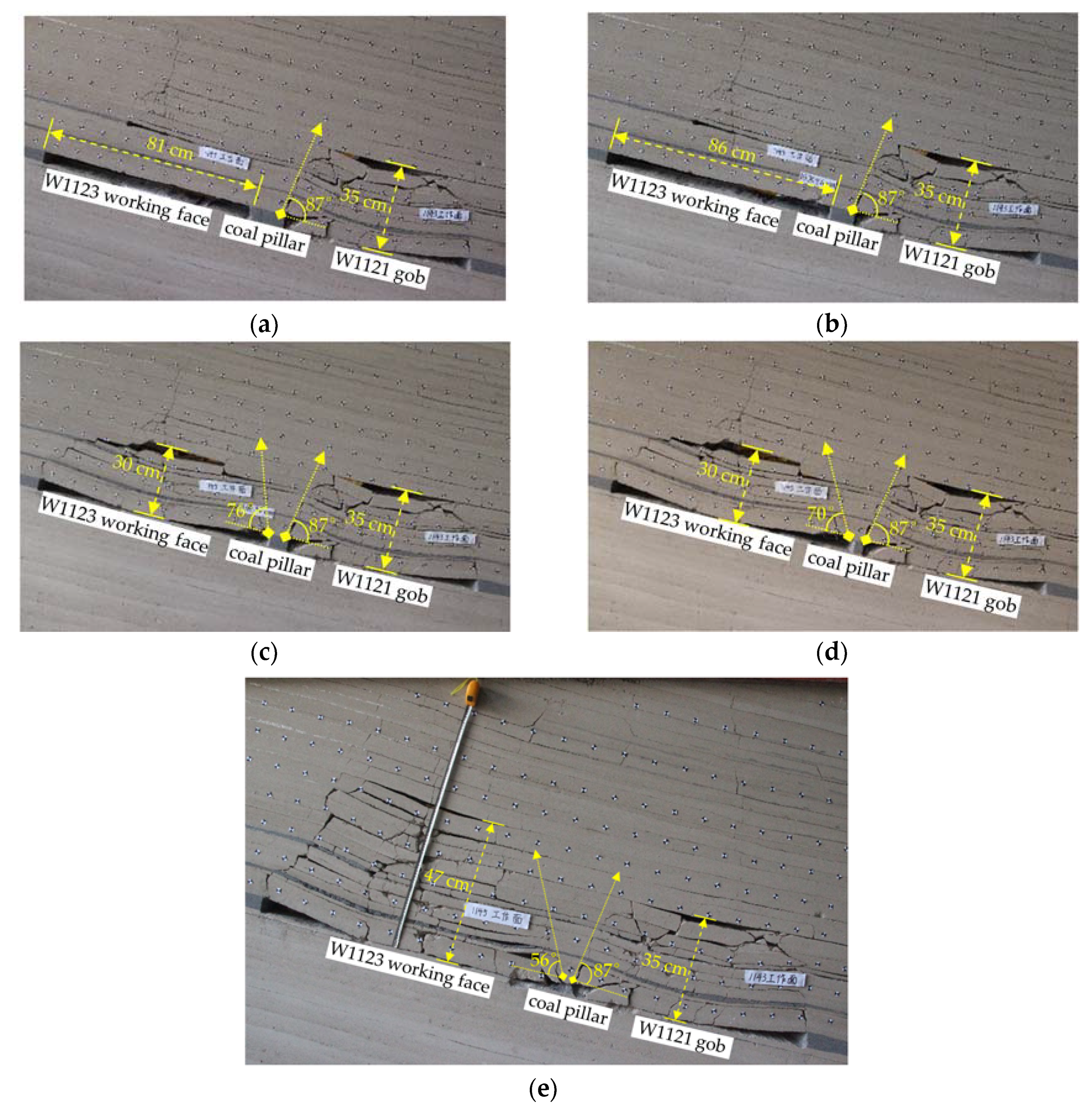

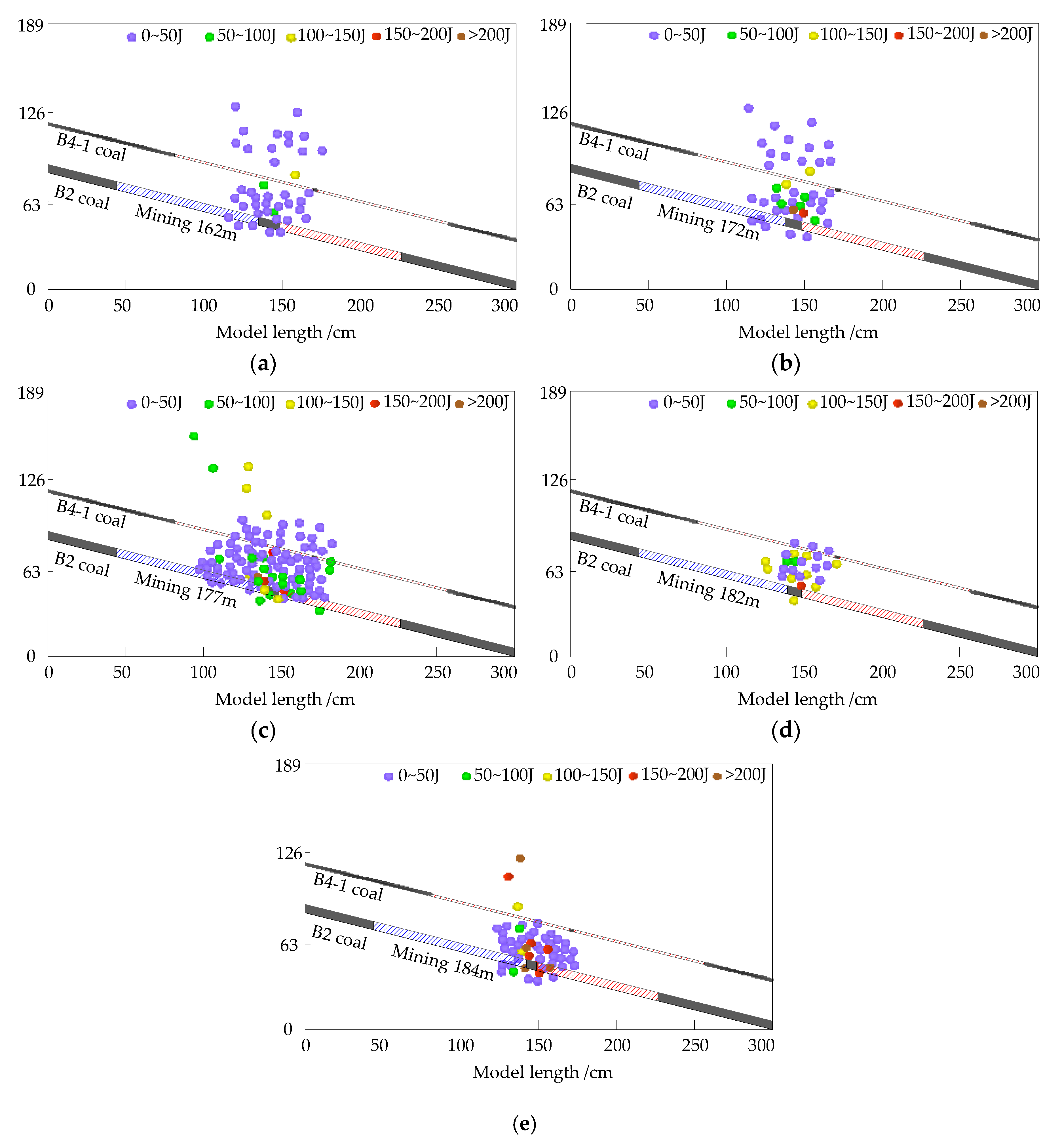
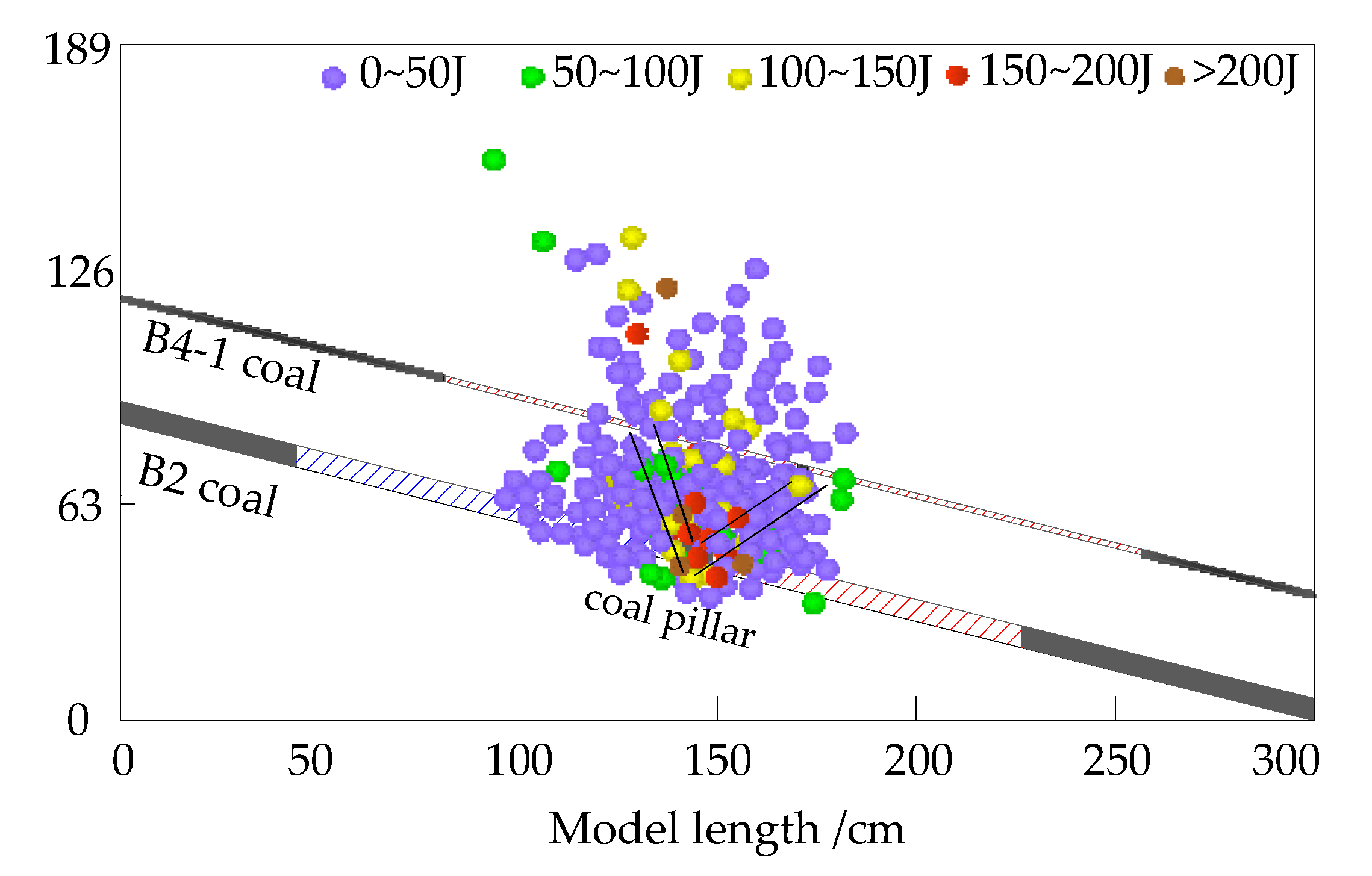



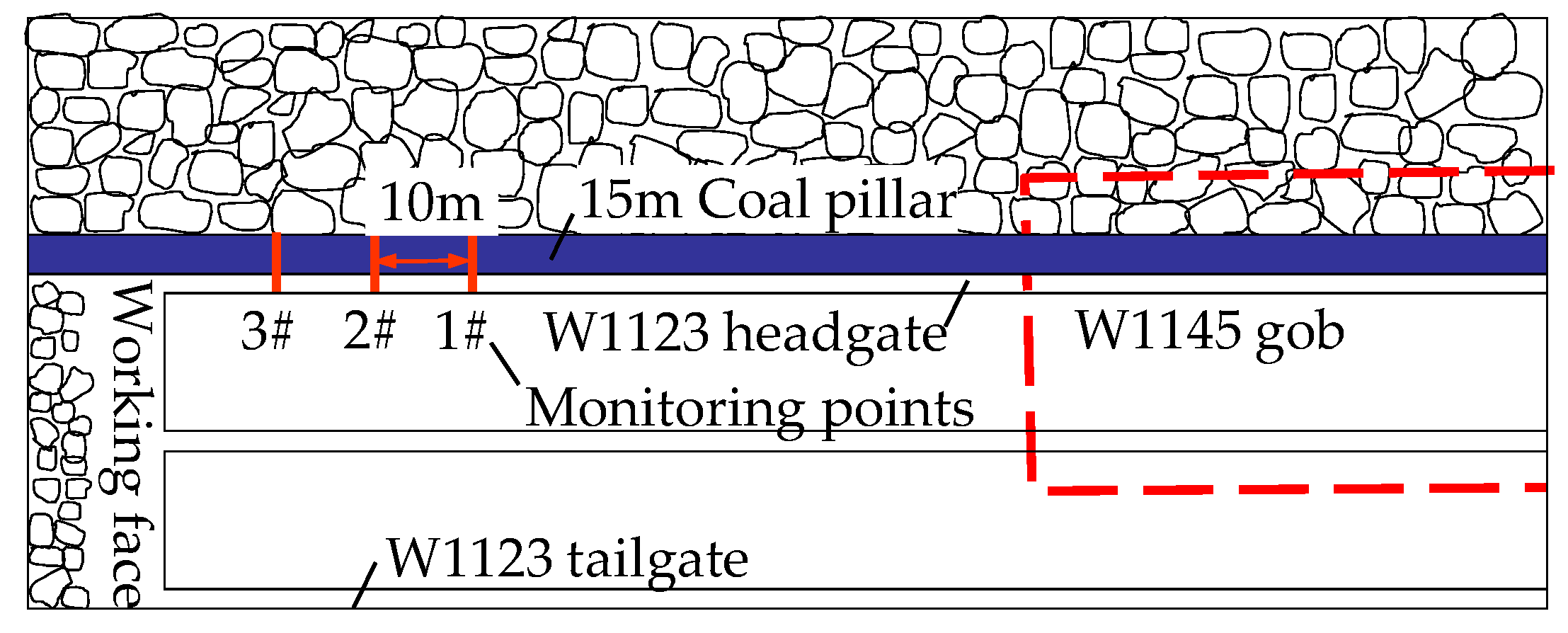
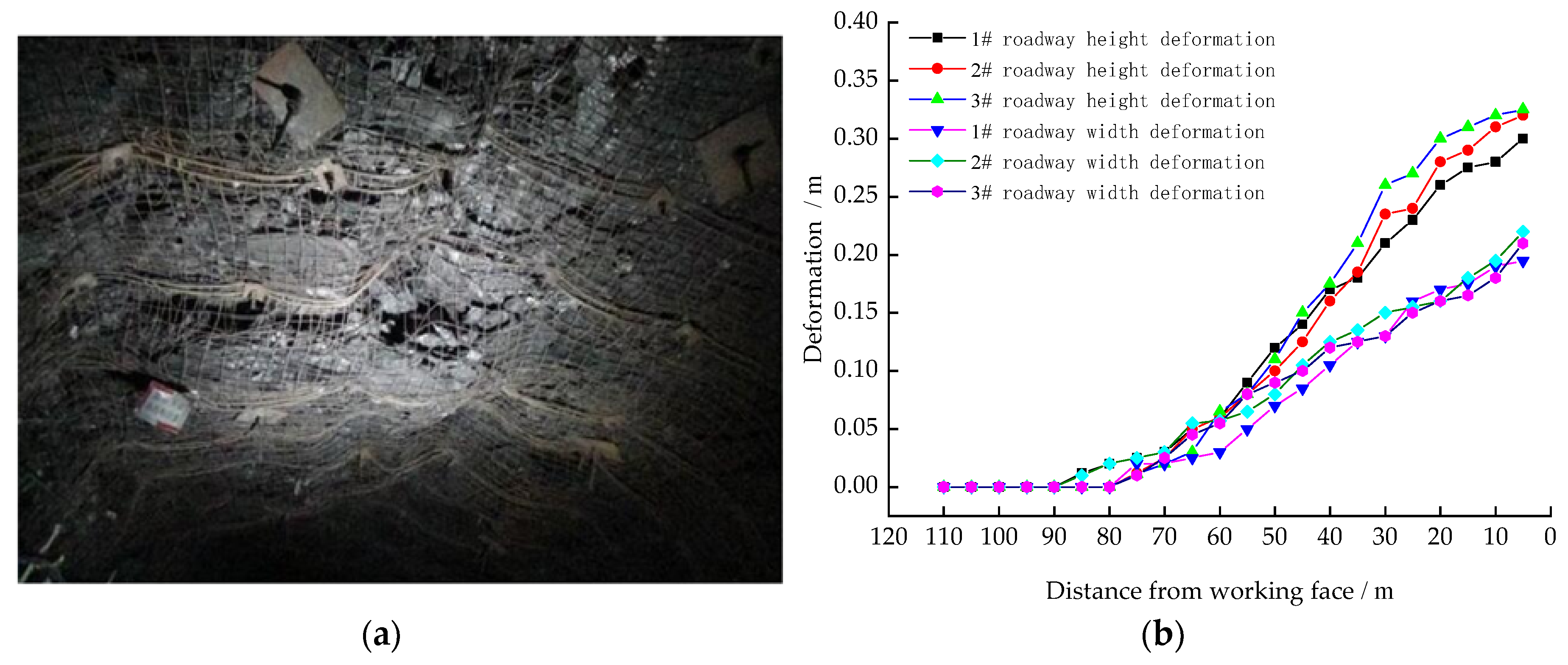
| Working Face Width | Roof Structure | Coal Pillar Load |
|---|---|---|
| short | rock beam | |
| medium | double articulated | |
| length | multi articulated |
| NO. | Lithology | Unit Weight/(kN/m3) | Tensile Strength (MPa) | Bulk Modulus (GPa) | Shear Modulus (GPa) | Cohesion (GPa) | Internal Friction Angle (°) |
|---|---|---|---|---|---|---|---|
| 1 | Sandy mudstone | 2546 | 5.16 | 8.12 | 4.41 | 2.62 | 30.4 |
| 2 | Coarse sandstone | 2541 | 7.48 | 13.45 | 10.94 | 4.48 | 29.7 |
| 3 | Fine sandstone | 2631 | 8.46 | 19.57 | 14.07 | 3.17 | 28.3 |
| 4 | coal | 1576 | 2.03 | 1.47 | 0.66 | 1.68 | 29.1 |
| 5 | Mudstone | 2467 | 3.17 | 7.42 | 3.83 | 2.28 | 31.7 |
© 2020 by the authors. Licensee MDPI, Basel, Switzerland. This article is an open access article distributed under the terms and conditions of the Creative Commons Attribution (CC BY) license (http://creativecommons.org/licenses/by/4.0/).
Share and Cite
Cui, F.; Dong, S.; Lai, X.; Chen, J.; Jia, C.; Zhang, T. Study on the Fracture Law of Inclined Hard Roof and Surrounding Rock Control of Mining Roadway in Longwall Mining Face. Energies 2020, 13, 5344. https://doi.org/10.3390/en13205344
Cui F, Dong S, Lai X, Chen J, Jia C, Zhang T. Study on the Fracture Law of Inclined Hard Roof and Surrounding Rock Control of Mining Roadway in Longwall Mining Face. Energies. 2020; 13(20):5344. https://doi.org/10.3390/en13205344
Chicago/Turabian StyleCui, Feng, Shuai Dong, Xingping Lai, Jianqiang Chen, Chong Jia, and Tinghui Zhang. 2020. "Study on the Fracture Law of Inclined Hard Roof and Surrounding Rock Control of Mining Roadway in Longwall Mining Face" Energies 13, no. 20: 5344. https://doi.org/10.3390/en13205344








